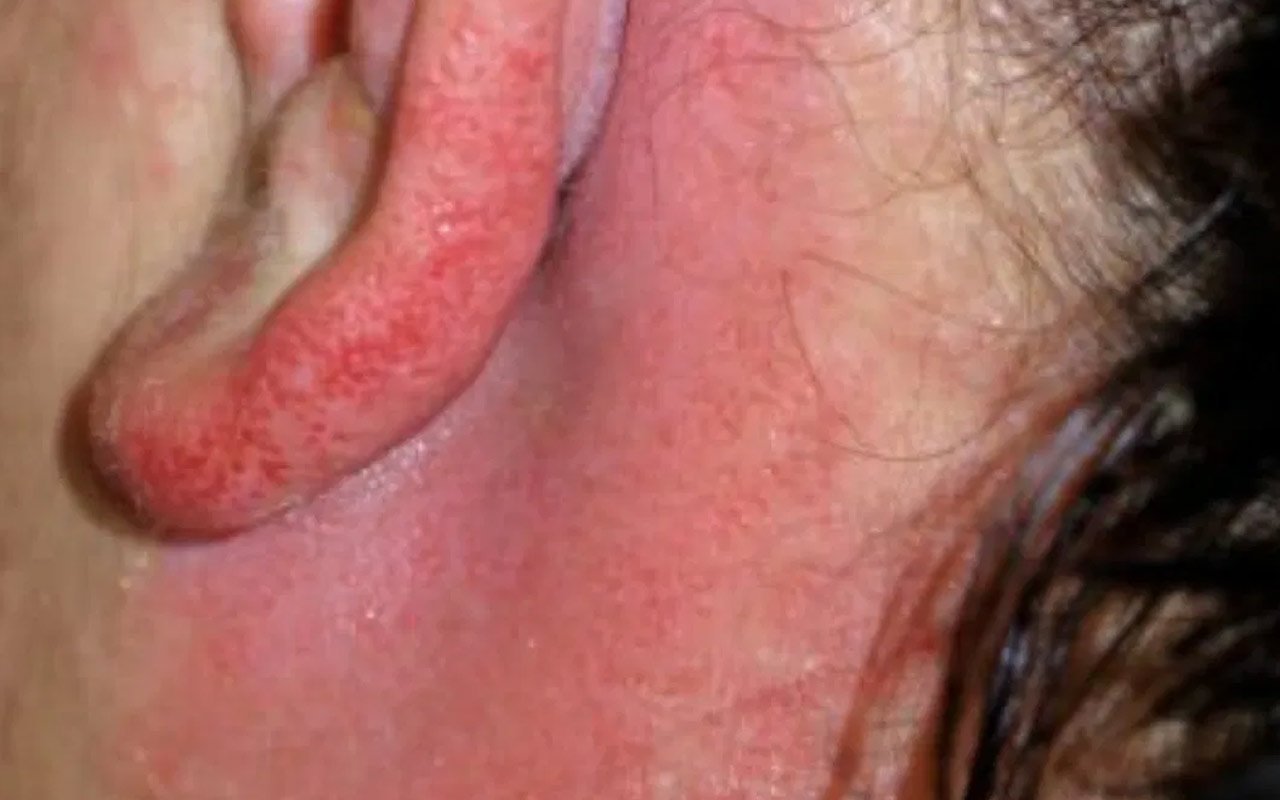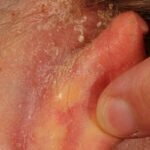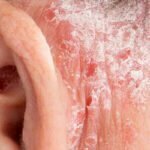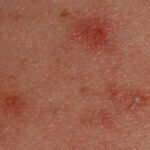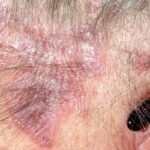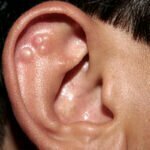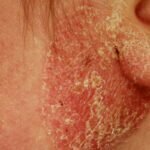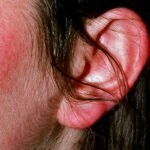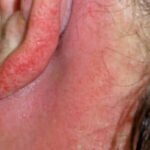Learn about the causes, symptoms, and treatments of rashes behind the ear. This article includes information on common causes, symptoms, and treatments for rashes behind the ear. If you’re experiencing a rash behind your ear, this article can help you understand what’s causing it and how to treat it.
A rash behind the ear can occur from a variety of causes and medical conditions. Certain viral infections and autoimmune diseases can cause a rash behind the ears in both children and adults. Some types of rash behind the ears caused by contact dermatitis are usually not concerning, but other causes, including rubella, ear eczema, and seborrheic dermatitis can be more serious. Here are all things you need to know about the causes, symptoms, and treatments for rashes behind the ears.
The delicate skin behind the ears is a common source of rashes. They can be hard to treat as you cannot see the affected area.
A rash behind your ears can be caused by many things, including skin irritation from haircare products and fungal infections.
Children and adults can get a rash behind their ears from viral infections or autoimmune diseases. Although some causes aren’t serious, like contact dermatitis or autoimmune diseases, there may be other more serious causes such as rubella.
We will be discussing the possible causes and treatment options for a rash behind your ear.
Table of Contents
What can cause a rash behind the ear?
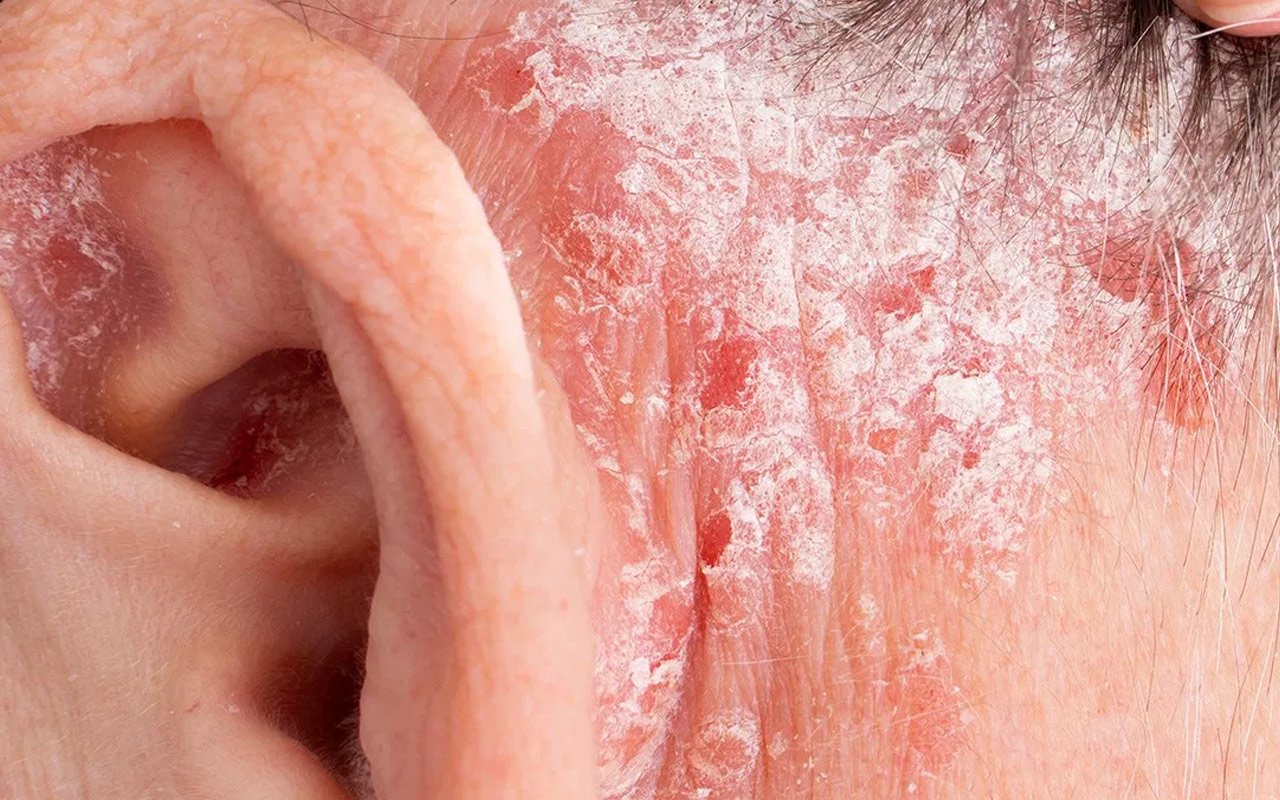
A rash behind the ears can be caused by a variety of things, including:
- Contact dermatitis: This is a type of allergic reaction that can be caused by things like jewelry, hair products, or cosmetics.
- Seborrheic dermatitis: This is a chronic skin condition that causes oily skin and flaking.
- Impetigo: This is a contagious bacterial infection that causes small, red bumps that break open and crust over.
- Measles: This is a viral infection that causes a rash that starts behind the ears and spreads to the rest of the body.
If you have a rash behind your ears, it is important to see a doctor to get a diagnosis and treatment.
Itching behind the ears can cause redness, swelling, itching, and flaking of the skin. These symptoms can range from annoying to severe. Below is detailed information on the most common causes of rashes behind the ears.
Contact dermatitis
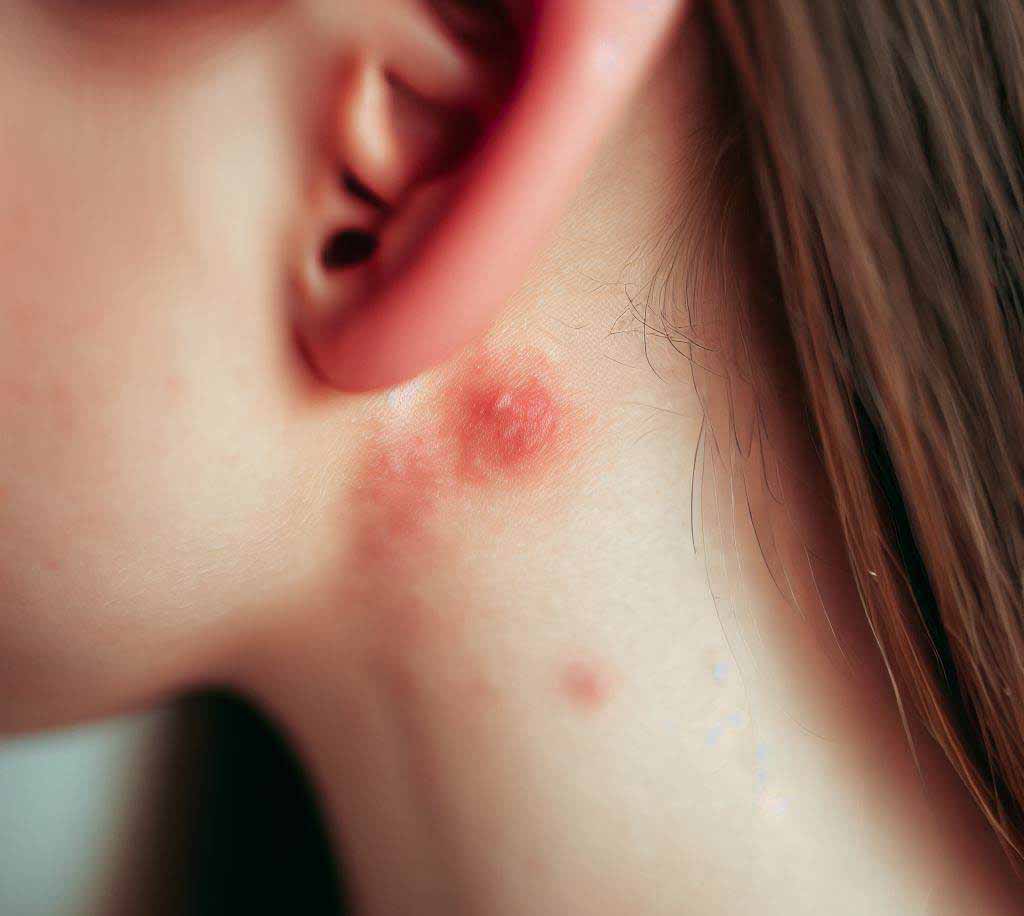
Contact dermatitis is a type of allergic reaction that occurs when the skin comes into contact with an irritant or allergen. A rash behind the ear is a common symptom of contact dermatitis. The rash may be red, itchy, and inflamed. In some cases, the rash may also be painful.
There are a number of things that can cause contact dermatitis, including:
- Jewelry made of nickel, cobalt, or copper
- Hair products
- Soaps
- Detergents
- Laundry softener sheets
- Cosmetics
- Plants, such as poison ivy, oak, or sumac
If you have a rash behind your ear, it is important to see a doctor to determine the cause and get the appropriate treatment. Treatment for contact dermatitis may include:
- Avoiding the irritant or allergen that caused the rash
- Applying a cool compress to the rash
- Taking an over-the-counter antihistamine, such as diphenhydramine (Benadryl)
- Using a topical corticosteroid cream, such as hydrocortisone
- In some cases, your doctor may prescribe a stronger corticosteroid cream or oral medication.
If you have a severe rash, you may need to see a dermatologist. A dermatologist is a doctor who specializes in the skin.
Here are some tips to help prevent contact dermatitis:
- Wear gloves when you are using harsh chemicals, such as cleaning products.
- Wash your hands frequently.
- Avoid wearing jewelry made of nickel, cobalt, or copper.
- Choose fragrance-free cosmetics and personal care products.
- If you have a known allergy to a particular plant, avoid contact with that plant.
By following these tips, you can help prevent contact dermatitis and keep your skin healthy.
Symptoms
Contact dermatitis is a condition that causes itching, dryness, flaking, and irritation of the skin.
Diagnosis
A doctor will diagnose contact dermatitis by taking the patient’s medical history and performing a physical exam. The relevant medical history includes hobbies, medications, as well as the use of perfumes and fragrances.
The doctor will then assess the patient’s symptoms and perform a patch test.
Sometimes, they might need to do a biopsy in order to confirm their diagnosis.
Treatment
Avoiding the substance that causes the reaction or rash is the best treatment.
Sometimes, a doctor might recommend oral or topical corticosteroids to reduce itching and inflammation.
Itching may be relieved by prescription and over-the-counter oral antihistamines.
People may find that applying cold, or even wet soaks to their skin soothes them and reduces itching. You can also use moisturizers.
Rash Behind the Ear Caused by Contact Dermatitis
Contact dermatitis is a common skin condition that causes inflammation and itching. It can occur anywhere on the body, including behind the ears. Contact dermatitis is caused by an allergic reaction to a substance that comes into contact with the skin. Common irritants that can cause contact dermatitis behind the ears include earrings, hair products, and shampoos.
If you have a rash behind your ear that you think may be caused by contact dermatitis, it is important to see a doctor to get a diagnosis and treatment. Treatment for contact dermatitis usually involves avoiding the irritant that is causing the reaction and using topical medications to reduce inflammation and itching.
Rubella
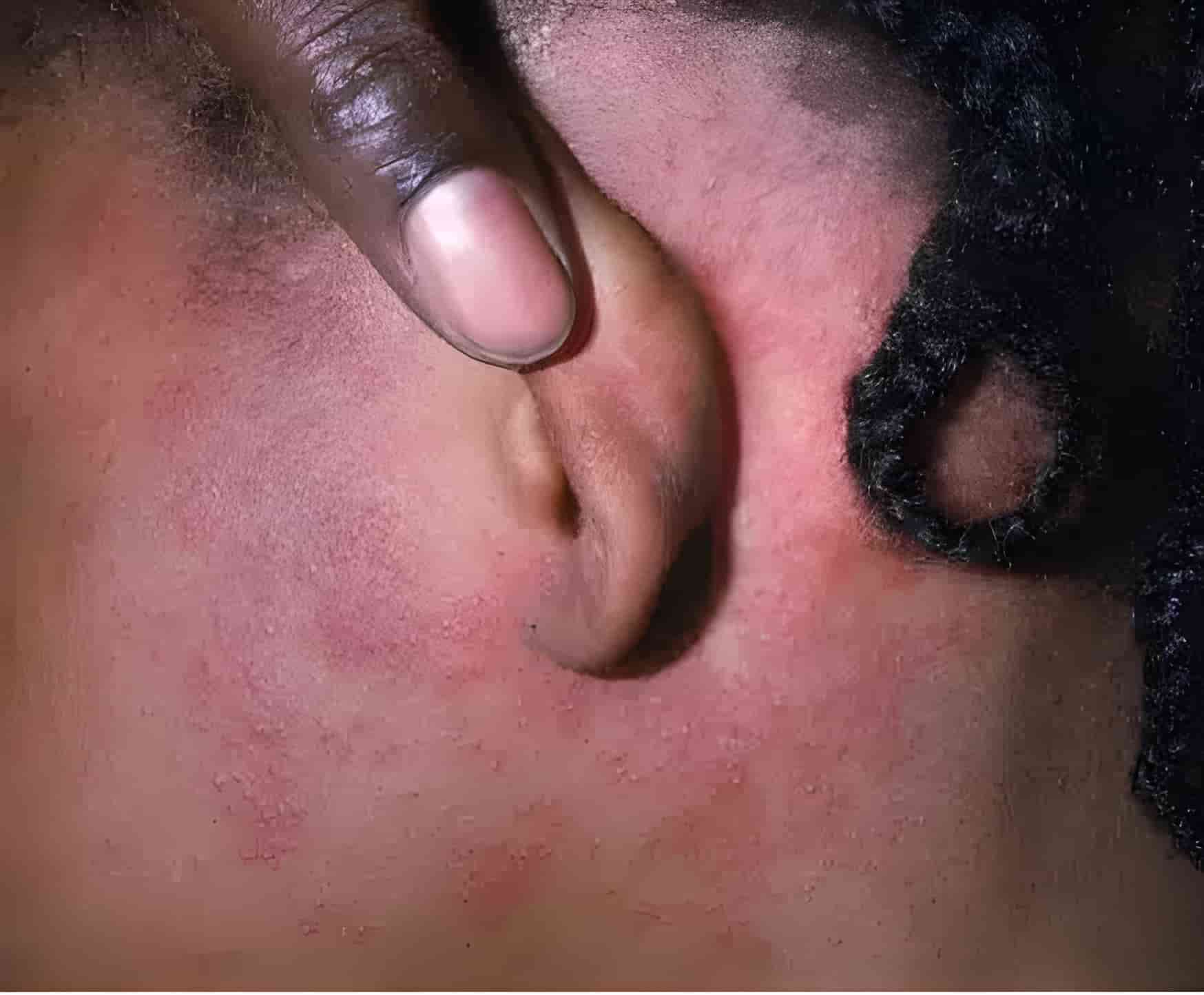
Rubella, also known as German measles is a rare viral infection that can affect children and young adults.
A 2020 article states that rubella is usually self-limiting and benign. According to the Centers for Disease Control and Prevention, most rubella cases in children and adults are mild.
Rubella can be fatal in pregnant women if it develops within the first ten weeks. These complications include severe congenital abnormalities, pregnancy loss, and fetal death.
Symptoms
According to the CDC, 25-50% will have rubella symptoms.
If symptoms do occur, however, they will often differ between adults and children.
According to the CDC, children often get a rash on their faces that spreads to their bodies. It will last for about three days.
You may also experience other symptoms 1-5 days before you get a rash.
- A headache
- Low-grade fever
- It is uncomfortable
- A cough
- Swollen lymph nodes
- A mild case of pinkeye
- A runny nose
Rubella is a mild infection that affects adults. They have a sore neck and a low-grade fever. The rash first appears on the skin and then spreads to the entire body.
A person can be contagious starting 8 to 8 days before the rash occurs.
Diagnosis
Sometimes, the symptoms of rubella can be mild or nonspecific and doctors might find it difficult to diagnose based on a physical exam.
More accurate serology testing for rubella.
Doctors can test for antibodies to rubella-specific immunoglobulin M by using serology testing. These antibodies can be detected four days after the rash develops.
Treatment
Due to the 1969 introduction of a vaccine, rubella incidence has decreased in many countries.
Rubella is not curable. If you have symptoms, it is important to get prompt treatment.
Supportive treatments include fluids, antipyretics, and nonsteroidal anti-inflammatory drugs for fever and aches. These may be combined for some people.
Rash behind the ears caused by Rubella
Rubella, also known as German measles, is a contagious viral infection that can cause a rash behind the ears. The rash is usually red or pink and consists of small spots that may be slightly itchy. It usually starts behind the ears and spreads to the face, neck, and rest of the body. Other symptoms of rubella may include fever, headache, sore throat, and swollen lymph nodes.
Rubella is most common in children, but it can also occur in adults. The infection is usually mild and goes away on its own within a few days. However, rubella can be serious for pregnant women, as it can cause birth defects in the fetus.
If you think you or your child may have rubella, see a doctor right away. There is no specific treatment for rubella, but the doctor can recommend ways to relieve symptoms and prevent complications.
Scalp psoriasis
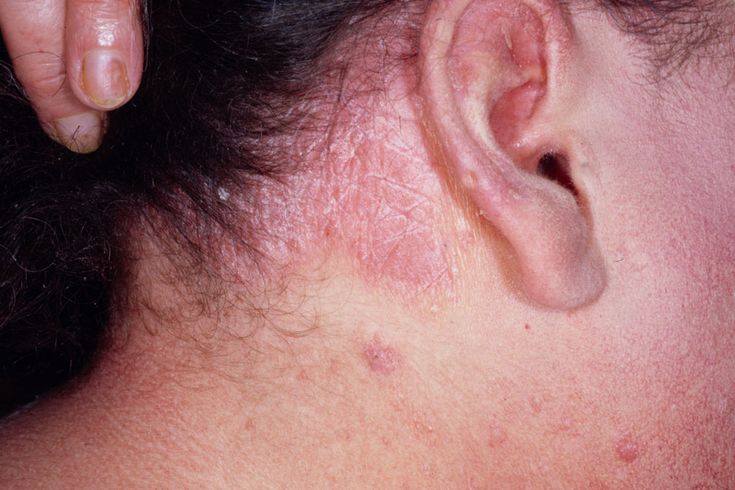
People suffering from scalp psoriasis may have discolored patches of thickened skin behind their ears.
Plaques can get itchy and flake easily, giving rise to a dandruff appearance.
Symptoms
Other signs of scalp psoriasis are:
- Silvery-white Scales
- Dry scales
- Dry, cracked scalp
- Itching
- Pain
- Burning
- Hair loss
Diagnosis
Psoriasis can usually be diagnosed by doctors by looking at the lesions on your skin.
Treatment
Topical treatments are possible for people suffering from scalp psoriasis. They typically have minimal involvement of the rest.
If they have large lesions, people may need systemic medication.
Some people use topical agents to treat scalp psoriasis.
- Coal tar
- Vitamin D analogs
- Corticosteroids
- Other shampoos that contain oils or other ingredients to reduce symptoms
These treatments can be difficult to apply due to the hair on the heads. Some people might stop using these products as a result.
Although localized ultraviolet B therapy can be used in place of topical medication, it is more expensive and is not widely accessible.
Systemic drugs are not approved for the treatment of scalp psoriasis. These drugs include:
- Methotrexate
- Cyclosporin A
- Biotherapy
Rash behind the ear caused by scalp psoriasis
Scalp psoriasis is a common skin condition that causes the skin to become inflamed and flaky. In some cases, scalp psoriasis can spread to other areas of the body, including behind the ears. A rash behind the ear caused by scalp psoriasis can look like red, scaly patches or plaques. The rash may be itchy and painful.
If you have a rash behind your ear that you think may be caused by scalp psoriasis, see your doctor for diagnosis and treatment. Treatment for scalp psoriasis can include topical medications, oral medications, and light therapy.
Measles
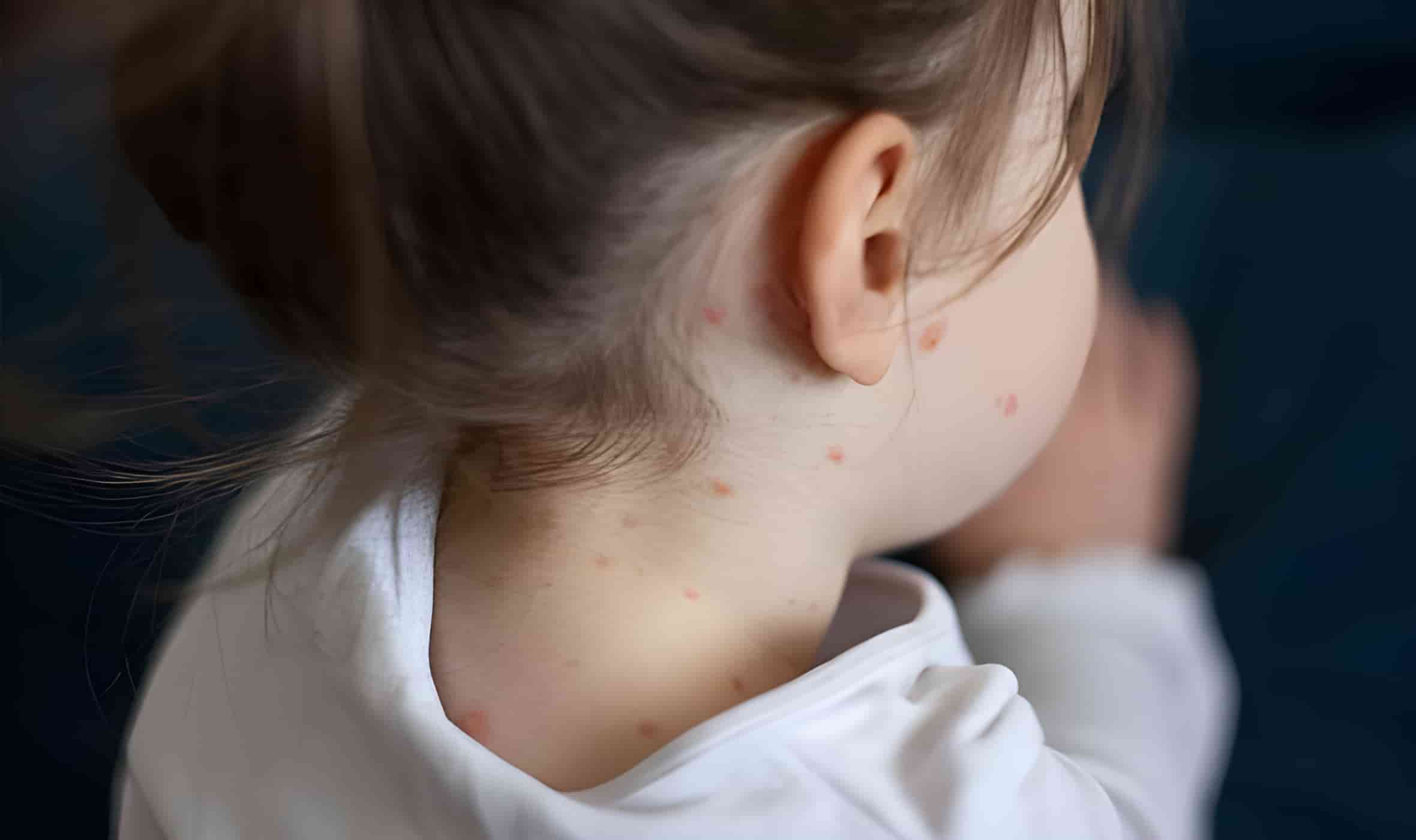
Measles is caused by the virus Rubeola.
Measles can be contracted from others via airborne particles.
The measles skin rash is located behind the ears and along your hairline. It can affect the trunk, face, arms, legs, and trunk.
According to the CDC, measles can pose a danger.
Complications are more common in children under 5 years old and older adults. These complications can include diarrhea, pneumonia, or encephalitis. Encephalitis refers to inflammation of the brain.
Symptoms
Doctors outline the three stages of measles-infected persons: prodromal (eruptive), and convalescent.
People may experience the following symptoms during the prodromal stage:
- High fever
- Malaise
- Inflammation of the nasal passages
- Inflammation of the inner eyelids
- Dry cough
The eruptive stage is when the patient develops a rash around the ears and along the hairline. This can spread to the trunk, face, and extremities.
The rash will disappear in the exact same way it appeared in the final stage.
After the rash begins, fever and general malaise can be treated within 2 to 3 days.
Diagnosis
Doctors look at symptoms and how measles spreads in the community to diagnose measles. They also examine laboratory results.
A blood test can be used to check for certain immunoglobulins, and it can also be used to isolate the virus responsible.
Treatment
Getting vaccinated can help stop the spread of measles.
The CDC recommends that children get their vaccinations at 12-15 months old and a booster shot at 4-6 years.
Although there is no cure, doctors might prescribe medicine to treat measles.
Rash behind the ear caused by Measles
A rash behind the ear can be a symptom of measles. Measles is a highly contagious viral infection that can cause a fever, cough, runny nose, and a rash. The rash usually appears 3-4 days after the other symptoms start. It starts on the face and behind the ears and then spreads to the rest of the body. The rash is usually red and blotchy and can be itchy.
If you have a rash behind your ear and you are experiencing other symptoms of measles, such as a fever, cough, or runny nose, you should see a doctor. Measles can be a serious illness, but it is usually preventable with the measles vaccine.
Intertrigo
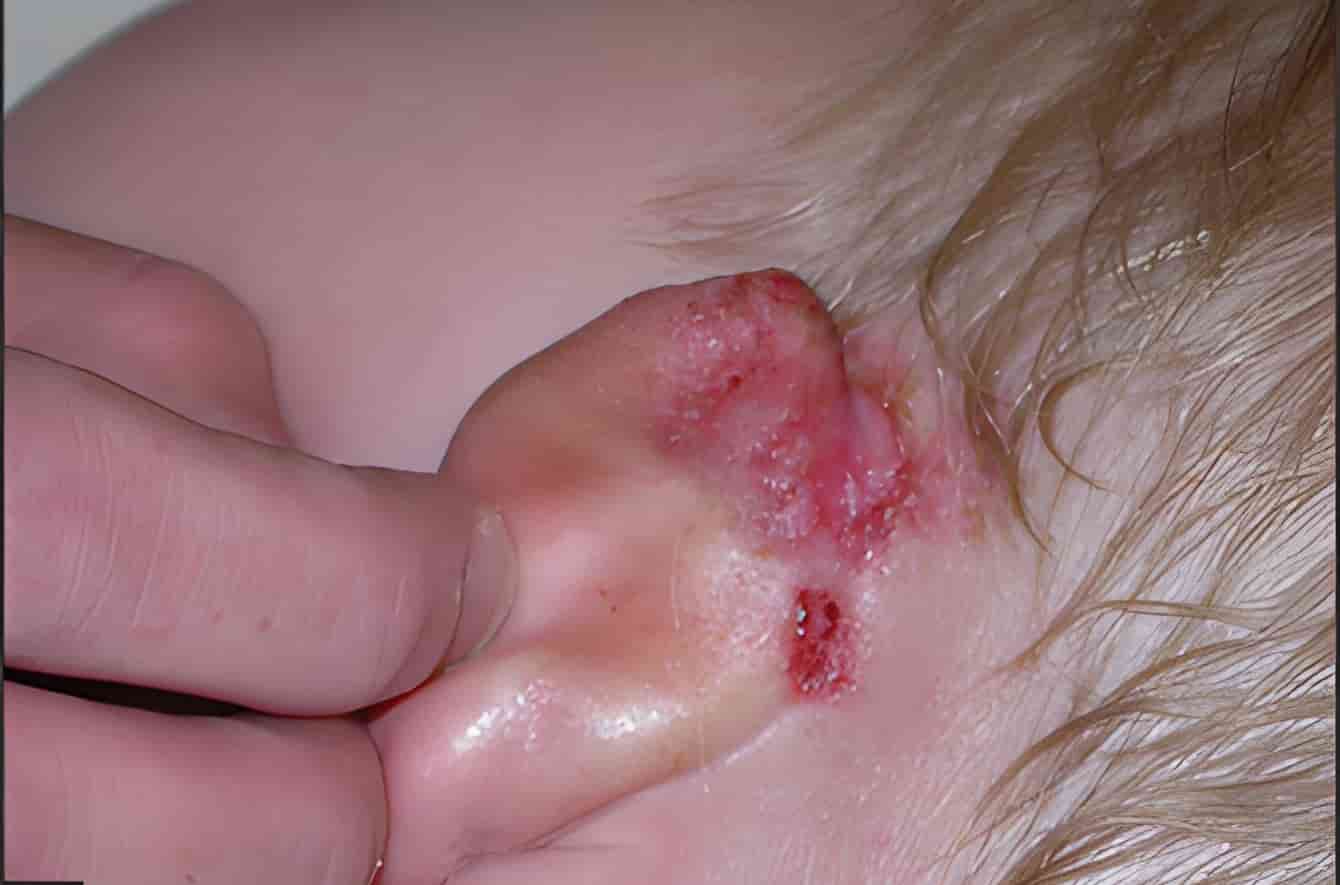
Intertrigo can happen at any age but is more common in older people. A person with a weak immune system is also at greater risk. Intertrigo behind the ears may occur in babies who drool while they sleep.
Intertrigo is when the skin rubs against another part of the skin that is moistened or frictional. The skin may become inflamed.
Intertrigo can also be caused by bodily secretions like saliva, sweat, and urine.
Symptoms
Intertrigo symptoms include:
- Flushed skin
- Itching
- Stinging
- A burning sensation
Diagnosis
To identify the type and severity of the rash, doctors need to inspect the skin.
A careful examination could reveal secondary fungal or bacterial infections that will require additional treatment.
Treatment
There are several first-line options for treatment:
- Zinc oxide ointments
- Petrolatum
- Talcum powder
- Aluminum sulfate
- Calcium acetate solution
- Low potency corticosteroids
If the doctor diagnoses secondary fungal or bacterial infections, the patient may need antibacterial or antifungal treatment.
- Topical erythromycin
- Topical clindamycin
- Chlorhexidine
- Whitfield’s ointment
- Topical mupirocin
There are some infections that may require oral antibiotics such as penicillin or clindamycin. Oral antifungal agents such as fluconazole might also be required.
Intertrigo is a type of skin rash that occurs in skin folds, such as behind the ears. It is caused by moisture and friction and is often worse in warm, humid weather. Intertrigo can cause itching, redness, and swelling. In severe cases, it can lead to a secondary infection.
There are a few things you can do to treat intertrigo behind the ear:
- Keep the area clean and dry.
- Apply a cool compress to the area.
- Use a hydrocortisone cream to reduce inflammation.
- See a doctor if the rash is severe or does not improve with home treatment.
COVID-19
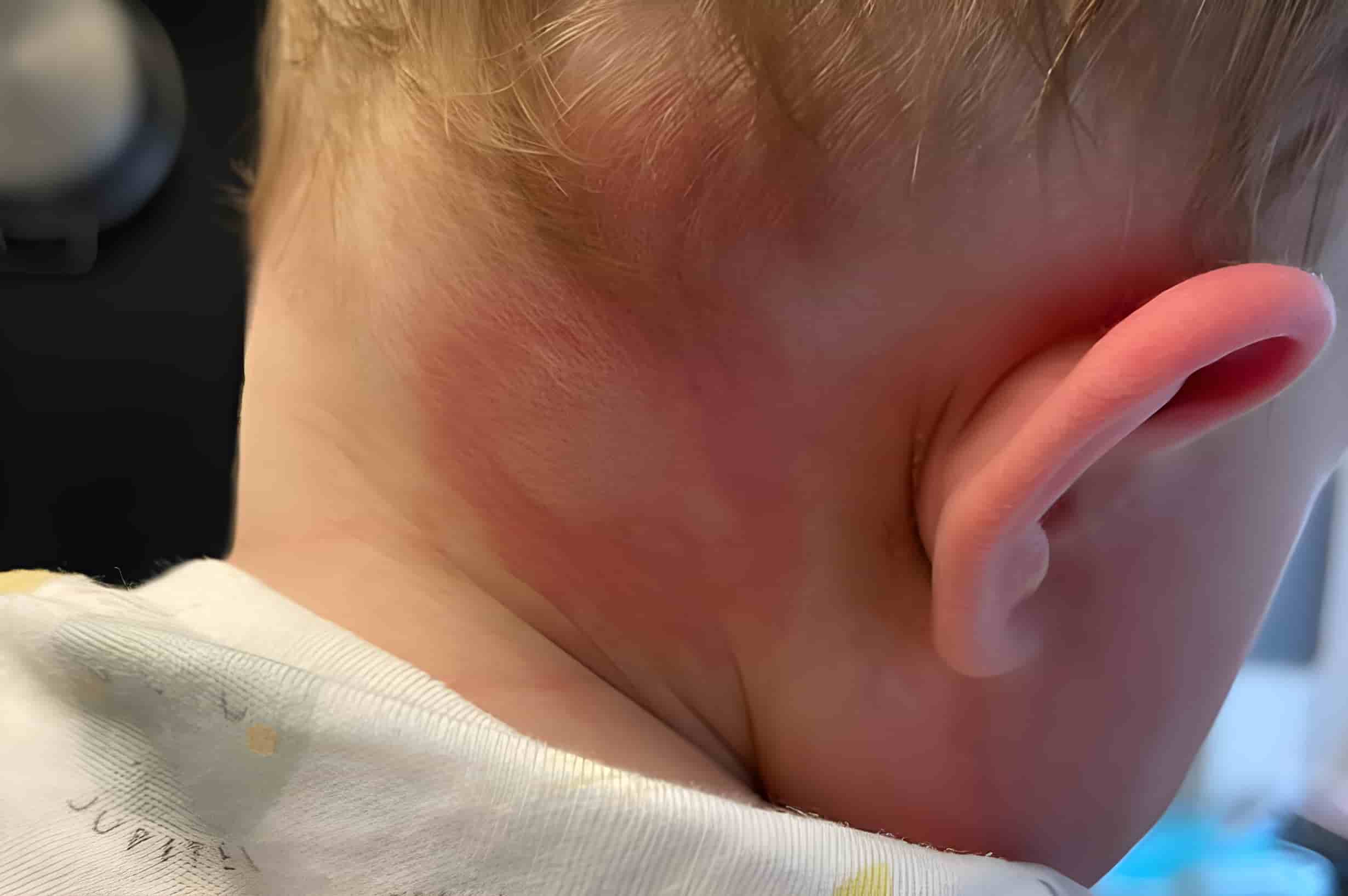
COVID-19 can also be the cause of a rash behind the ears. Dermatologists have seen measles-like bumps on the chest, back, ears, and other areas of COVID-19 patients.
Although unproven because large enough research data are not available, some recent studies suggest the possibility of skin rash as a clinical manifestation of coronavirus disease 2019 (COVID-19).
The rash can last for weeks while you are recovering from COVID. A large and itchy rash with small lumps and blisters may appear during COVID or several weeks later.
Some people may develop a widespread maculopapular rash (a flat or raised skin discoloration), while others may develop hives. This type of COVID-19 rash can appear with blisters that look like chickenpox.
Currently, reports show that a covid rash usually lasts 2 to 12 days, with most people having a rash for 8 days.
You can take care of your COVID-19 rash at home by applying cool compresses and using over-the-counter topical products. To relieve pain or itching, apply hydrocortisone cream to the affected area.
A rash behind the ear can be a symptom of COVID-19. The rash is typically flat or raised, and it can be red, pink, or purple. The rash may be itchy or painful, and it may appear on one or both ears. The rash usually goes away on its own within a few days. However, if the rash is severe or does not go away, see a doctor.
Here are some other symptoms of COVID-19:
- Fever
- Cough
- Fatigue
- Sore throat
- Runny or stuffy nose
- Muscle aches
- Headache
- Loss of taste or smell
- Diarrhea
- Congestion
- Pink eye
- Rash
If you have any of these symptoms, it is important to get tested for COVID-19.
Rash behind the ear in a baby and toddler
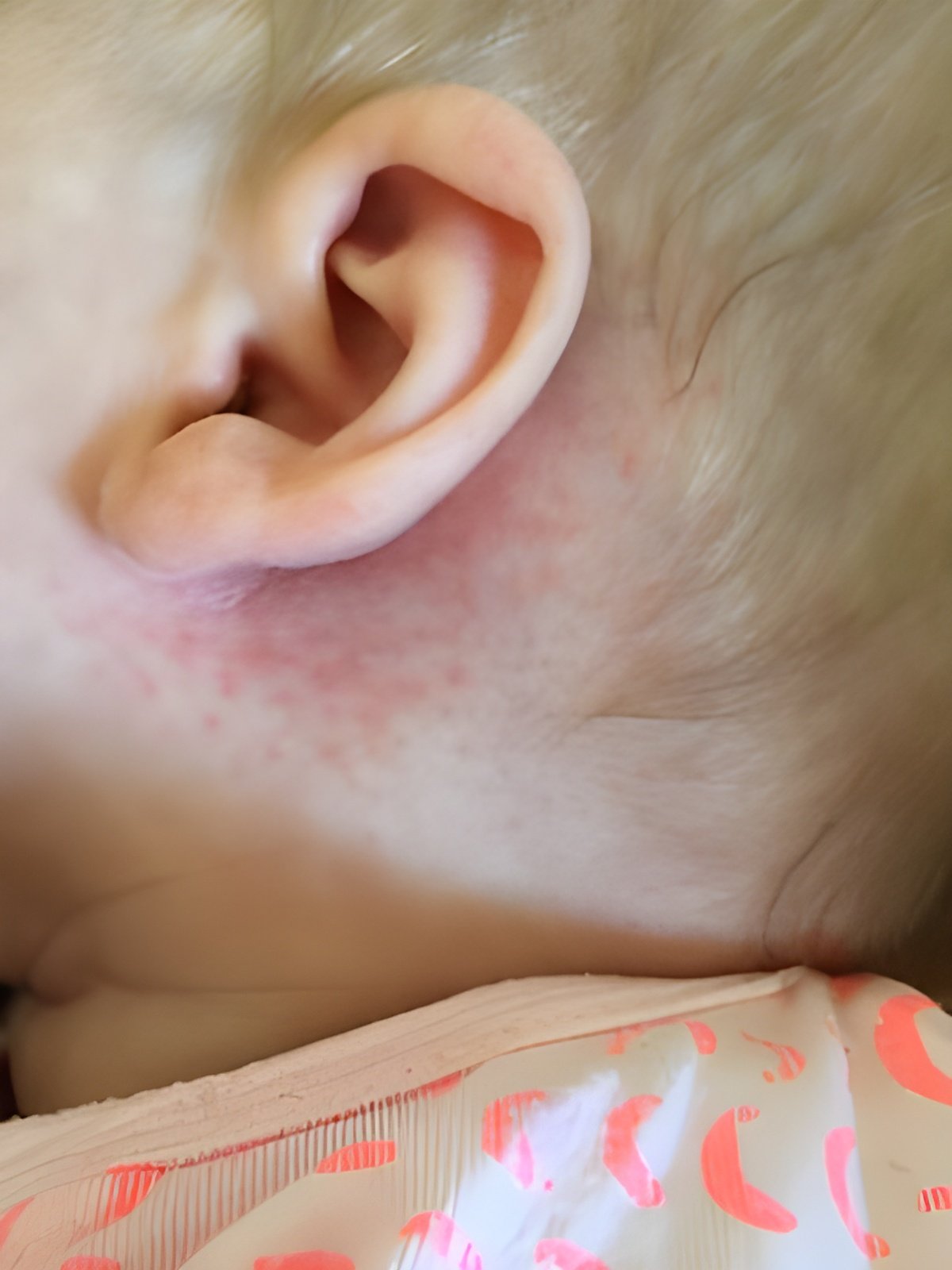
Rashes behind the ears in babies or toddlers are also common, and treatment is fairly straightforward. Children as young as two years old can get rashes behind their ears from conditions that adults do not normally experience.
Intertrigo behind the ears is one example. This skin condition can occur in the skin folds. Sometimes, a baby’s drool goes behind its ears. It can cause the skin to become hot, red, and painful.
Intertrigo can be treated by parents using zinc creams and other moisture barriers to prevent skin from becoming damaged.
Foot, hand, and mouth disease is another condition that can lead to a rash behind your ears. This is a common condition in preschools and childcare centers.
Heat rashes are caused by blockage and inflammation of the sweat ducts when heat and humidity are high, causing: tiny red bumps. Itching and tingling sensations. redness and slight swelling of the affected area.
Heat rash behind the ear is an itchy skin condition that affects the skin behind the ear, as well as most areas of the ear. This is a common disease in children.
The causes of heat rash behind the ears are many, but the main cause is a blockage and inflammation of sweat ducts in heat and high humidity, which causes: tiny red spots. an irritating itch and prickling sensation, redness, and mild swelling of the affected area.
Extremely hot weather or allergies to shampoos or skin care products can also cause heat rash behind the ears. Most cases of heat rash will clear up on their own within a few days with appropriate home care.
A child might also have a red, blistering skin condition, as well as a fever and a runny nose.
Seborrheic Dermatitis ( cradle cap), another condition that can affect babies, is also possible.
A rash behind the ear in a baby or toddler can be caused by a number of things, including:
- Eczema: Eczema is a common skin condition that causes inflammation and itching. It can occur anywhere on the body, including behind the ears.
- Contact dermatitis: Contact dermatitis is a type of allergic reaction that occurs when the skin comes into contact with an irritant. Common irritants that can cause contact dermatitis behind the ears include earrings, hair products, and shampoos.
- Fungal infection: Fungal infections can occur anywhere on the body, including behind the ears. Fungal infections can cause itching, redness, and scaling.
- Seborrhea: Seborrhea is a condition that causes the skin to produce too much oil. This can lead to itching, redness, and flaking of the skin.
- Ingrown hair: Ingrown hairs can occur anywhere on the body, including behind the ears. Ingrown hairs can cause itching, redness, and pain.
If your baby or toddler has a rash behind the ear, it is important to see a doctor to determine the cause and get the proper treatment.
Cradle cap
Seborrheic dermatitis is another name for cradle cap. Cradle cap is a skin condition that usually appears in infants, usually between 1-2 months of age. The scalp appears oily, and yellow and may be accompanied by an irritating red rash on the face, behind the ears, on the neck, and even under the armpits.
Symptoms
The following symptoms may be experienced in infants with cradle caps:
- The yellow crust on the skin
- Flushed skin with yellow or white flakes
- Inflammation
Although the cradle cap is not likely to cause agitation in babies, parents and caregivers should inspect the scalp for signs of infections.
Diagnosis
Because cradle caps can be caused by other skin conditions, doctors will examine infants with cradle caps.
Babies with cradle caps will have thick, greasy skin that does not cause itching.
Other conditions that could resemble cradle caps are:
- Eczema
- Fungal infections
- Psoriasis
- Rosacea
Treatment
The United Kingdom’s National Health Service states that a caregiver or parent can:
- Regularly wash your infant’s hair with baby shampoo
- Use a soft brush to gently brush your scalp
- Apply baby oil, vegetable oil, or petroleum jelly to the affected areas at night. Wash them the next morning with baby shampoo
Avoid using soap, peanut oil, or adult shampoos. As this could lead to infection, they should avoid picking at the crusts.
Rash behind the ears: Treatment
Rash behind the ear treatment: If you have a rash behind your ear, there are a few things you can do to treat it. First, try to keep the area clean and dry. You can also apply a cold compress to the area to help reduce inflammation and itching. If the rash is severe or does not improve with home remedies, see a doctor. They may prescribe a topical medication or antibiotic to help clear up the rash.
Here are some additional tips for treating a rash behind the ear:
- Avoid scratching the area. Scratching will only make the rash worse.
- Use a hydrocortisone cream. This can help to reduce inflammation and itching.
- Take an oatmeal bath. This can help to soothe the skin and reduce itching.
- See a doctor if the rash is severe or does not improve with home remedies.
A rash behind the ear can be caused by a number of things, including contact dermatitis, eczema, and infection. If you have a rash behind your ear, it is important to see a doctor to determine the cause and get the appropriate treatment. In the meantime, there are a few things you can do to relieve the symptoms, such as keeping the area clean and dry, applying a cool compress, and taking an over-the-counter antihistamine.
Here are some additional tips for treating a rash behind the ear:
- Avoid scratching the rash, as this can make it worse.
- If the rash is caused by an allergy, try to avoid the allergen that is causing the reaction.
- If the rash is caused by eczema, use a moisturizer to keep the skin hydrated.
- If the rash is caused by an infection, your doctor may prescribe antibiotics.
With proper treatment, most rashes behind the ear will clear up within a few days. However, if the rash does not improve or gets worse, see your doctor again.
Medical treatment
The treatment for a rash behind the ear depends on the cause and severity of the condition. Some general tips are:
- Avoid scratching or rubbing the affected area
- Keep the area clean and dry
- Apply cold or wet compresses to soothe the skin and reduce inflammation
- Use moisturizers to prevent dryness and cracking
- Avoid using harsh or irritating products on the skin or hair
- Consult a doctor if the rash is severe, persistent, spreading, or accompanied by other symptoms such as fever, pain, swelling, or drainage.
Some specific treatments for different causes are:
- For viral infections, you may need antiviral medications or vaccines
- For fungal infections, you may need antifungal creams, shampoos, or pills. Antifungal ear drops, such as fluconazole and clotrimazole, are effective treatments for many types of fungal ear infections. Your healthcare provider may also recommend aluminum acetate or acetic acid ear drops to reduce inflammation in your ear canal. It is important to use ear drops exactly as directed to ensure that the infection is treated effectively.
- For contact dermatitis, you may need antihistamines or corticosteroids to reduce itching and inflammation
- For autoimmune diseases, you may need topical or oral medications that modulate the immune system or reduce inflammation.
If the rash behind your ears is caused by a fungal infection or bacterial disease, a doctor might prescribe treatment. A fungal rash is often red and itches or burns. This fungus infection causes pain and itching. The infection can also cause a feeling of fullness in the ear and sometimes hearing loss.
There is no specific treatment for viral infections that cause a rash behind the ear. The rash will usually go away on its own within a few days or weeks. In the meantime, there are some things you can do to relieve the itching and discomfort, such as:
- Apply a cool compress to the area.
- Take an over-the-counter antihistamine, such as diphenhydramine (Benadryl).
- Use a hydrocortisone cream or ointment.
- Avoid scratching the rash, as this can make it worse.
If the rash is severe or does not go away after a few weeks, see a doctor. They may prescribe stronger medication or recommend other treatments.
Here are some of the most common viral infections that can cause a rash behind the ear:
- Rubella: Rubella, also known as German measles, is a mild illness that is usually caused by the rubella virus. It is most common in children, but can also occur in adults. The rash usually appears on the face and behind the ears and is often accompanied by a fever, sore throat, and swollen lymph nodes.
- Measles: Measles is a serious illness that is caused by the measles virus. It is highly contagious and can spread through the air by coughing or sneezing. The rash usually appears on the face and behind the ears and is often accompanied by a fever, cough, runny nose, and sore throat.
- Hand, foot, and mouth disease: Hand, foot, and mouth disease is a common illness that is caused by the coxsackievirus A16 or enterovirus 71. It is most common in children, but can also occur in adults. The rash usually appears on the hands, feet, and mouth, and is often accompanied by a fever, sore throat, and headache.
If you think you or your child has a viral infection that is causing a rash behind the ear, see a doctor for diagnosis and treatment.
It’s important to remember, otomycosis is a fungal infection that affects one or sometimes both ears. It mainly affects people living in warm or tropical areas. It also can affect people who regularly swim, have diabetes, or have other chronic skin conditions.
These treatments include topical antifungal medications or oral antibiotics. This is especially true when the skin is infected, bleeding, cracked, or damaged.
Your doctor will likely prescribe antifungal ear drops. They may contain clotrimazole, fluconazole, or miconazole. Scientific research proves that clotrimazole drops, miconazole cream, and fluconazole drops have the same effect.
You can also use apple cider vinegar to treat fungal infections behind the ears. Known for its ability to fight chronic yeast infections, apple cider vinegar can also kill the fungi that cause ear infections.
To use apple cider vinegar for ear infections, mix one part apple cider vinegar with one part water. Dip a cotton ball in the solution, then use a cotton pad soaked in the apple cider vinegar solution to clear the rash. This is the best home treatment for rash behind the ears caused by a fungal infection.
Autoimmune diseases can cause a variety of symptoms, including rashes. A rash behind the ear can be a sign of several autoimmune diseases, including:
- Lupus: Lupus is a chronic autoimmune disease that can affect many parts of the body, including the skin. A rash behind the ear is a common symptom of lupus.
- Sjögren’s syndrome: Sjögren’s syndrome is an autoimmune disease that affects the moisture-producing glands in the body, including the salivary glands and tear glands. A rash behind the ear can be a symptom of Sjögren’s syndrome.
- Dermatomyositis: Dermatomyositis is an autoimmune disease that affects the muscles and skin. A rash behind the ear is a common symptom of dermatomyositis.
If you have a rash behind the ear, it is important to see a doctor to determine the cause. Treatment for a rash caused by an autoimmune disease will vary depending on the underlying disease. However, treatment may include medications to suppress the immune system, topical treatments to reduce inflammation, and lifestyle changes to manage symptoms.
Here are some tips for managing a rash behind the ear caused by an autoimmune disease:
- Keep the area clean and dry. Wash the area with soap and water twice a day. Pat the area dry with a clean towel.
- Apply a cool compress to the area. This will help to reduce inflammation and itching.
- Use a topical steroid cream. This will help to reduce inflammation and itching.
- Take over-the-counter antihistamines. This will help to reduce itching.
- See a doctor if the rash does not improve. Your doctor may prescribe stronger medications or other treatments.
It is important to note that there is no cure for autoimmune diseases. However, with proper treatment, you can manage your symptoms and live a normal life.
Home remedies
Some home remedies that may help with a rash behind the ear are:
- Clean the affected area with soap and warm water. Always wash your hands before and after touching the rash.
- Apply a fragrance-free anti-itch ointment, or antibiotic skin cream, depending on your symptoms. Loosely cover the area with a bandage or gauze if needed.
- Refrain from scratching or rubbing the rash, as this can worsen the inflammation and infection.
- Use a cool compress or a wet cloth to soothe the rash and reduce the swelling.
- Moisturize the skin behind the ear with a gentle lotion or oil to prevent dryness and cracking.
- Avoid common allergens or irritants, such as earrings made of nickel, cobalt, or copper, or hair care products that contain harsh chemicals or fragrances.
- Use a humidifier if dry air makes your skin dry. Wear a warm hat that covers your ears when you’re out in cold weather.
- If you are looking for natural remedies for rash behind ear, you may want to try tea tree oil or aloe vera gel. These are two of the most effective natural remedies for rash behind ear, as they can help reduce the itching and inflammation caused by various skin conditions. Tea tree oil has antifungal and antibacterial properties, which can help prevent or treat infections. Aloe vera gel has soothing and healing effects, which can help moisturize and repair the skin. To use these natural remedies, apply a small amount of either tea tree oil or aloe vera gel to the affected area and leave it on for 15 to 20 minutes, then rinse it off with water. Repeat this process twice a day until the rash improves
- If the rash is caused by a fungal infection, such as ringworm, you may need to use an antifungal cream or shampoo to treat the infection. Follow the instructions on the product label and use it for the recommended duration.
If the rash does not improve or worsens after trying these home remedies, you should see a doctor for a proper diagnosis and treatment.
You should also seek medical attention if the rash is accompanied by other symptoms, such as fever, pain, bleeding, or hearing loss.
These could indicate a more serious condition, such as an allergic reaction, an infection, or an autoimmune disorder.
How to diagnose a rash behind the ear?
A rash behind the ear can be caused by a variety of things, including eczema, contact dermatitis, fungal infections, and seborrhea. If you have a rash behind your ear, it is important to see a doctor to determine the cause and get the proper treatment.
Here are some of the symptoms of a rash behind the ear:
- Itching
- Redness
- Swelling
- Blisters
- Flaking
- Pain
If you have any of these symptoms, see a doctor to get a diagnosis and treatment.
Here are some of the things that your doctor may do to diagnose a rash behind the ear:
- Ask you about your medical history
- Examine the rash
- Take a sample of the rash for testing
Once your doctor has diagnosed the cause of your rash, they will recommend a treatment plan. Treatment for a rash behind the ear may include:
- Medications, such as antihistamines, antifungals, or steroids
- Topical treatments, such as creams or ointments
- Home remedies, such as keeping the area clean and dry, applying a cold compress, or using an oatmeal bath
When to see a doctor?
The rash can be caused by many medical conditions. Undiagnosed rashes are best treated by a physician or another healthcare provider.
Additional symptoms such as fever, malaise, or nausea may indicate an infection. You should seek immediate medical attention.
A rash can become infected if it is scratched repeatedly. A doctor should be consulted if you have a rash or develop an infection.
Rashes can appear behind the ears due to different skin conditions like contact dermatitis or psoriasis.
A rash may occur in people who have measles or rubella infections. Infants with rash behind the ears are more likely to have intertrigo or cradle caps.
If a rash develops along with other symptoms such as fever or severe discomfort, it should be treated immediately.
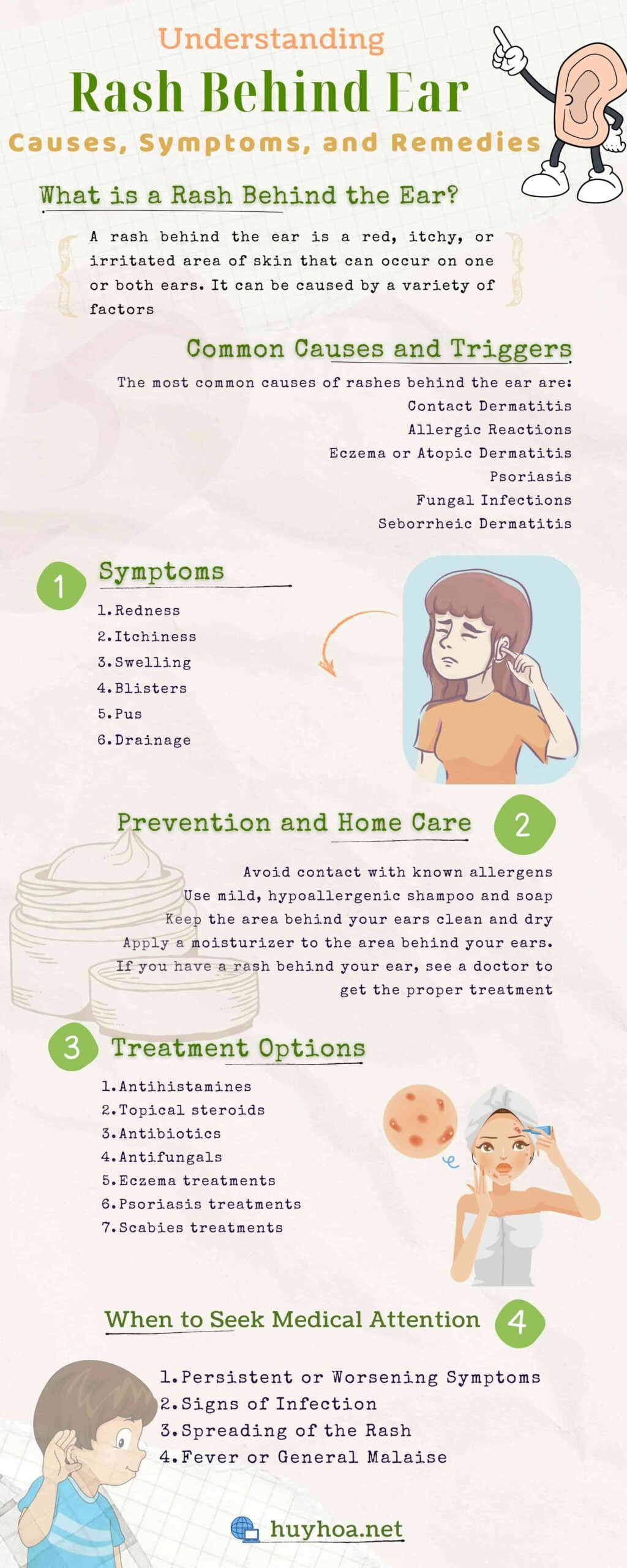
Rash behind the ears: Pictures
Here are some pictures of the rash behind the ear.
- What can cause a rash behind the ear?
- rash behind the ears
- red rash of measles
- Lichen planus lesions are known to be purplish.
- Granuloma annulare is very common. It presents as skin-colored, round lesions and is noncancerous.
- Fungal infections can be transmitted from an animal to humans.
- A lupus rash isn’t itchy and appears as red bumps on sun-exposed areas of skin.
- A common rash behind the ear, known as periorificial dermatitis, can cause discomfort and irritation.
Frequently Asked Questions
How to Get Rid of Rash behind the Ears?
There are home remedies as well as over-the-counter medicines that may help to treat a rash behind the ears and prevent it from spreading. It all depends on the severity and type of the rash.
To prevent skin conditions such as rashes or other skin conditions, it is important that the skin behind the ears is dry and clean.
Atopic dermatitis is not curable. However, symptoms can be managed with topical corticosteroids such as vitamin D and hydrocortisone.
The anti-inch creams can be used to treat the symptoms until the rash goes away on its own.
You might try different soaps and cleaning products to prevent contact rash.
Scalp psoriasis can be treated with phototherapy, corticosteroid creams, and moisturizers. Psoriasis has not been treated.
The anti-fungal medicine ketoconazole is not recommended for treating skin infections.
However, it has been proven to be effective in treating seborrheic dermatology.
Tea tree oil, a natural antimicrobial, is also a good option to treat rashes. It can also be used to treat fungal and bacterial infections.
Turmeric is an excellent natural remedy for rash symptoms such as redness and helps to stop it from spreading.
Its anti-inflammatory, antimicrobial and immunosuppressive components have proven to be very effective in treating rash behind the ears.
Although some of these remedies might help with some symptoms, it is important to know when you should seek medical attention.
If the rash becomes more severe or spreads, it's time for you to visit your doctor.
Sometimes, a rash behind the ear may go unnoticed until it becomes an itchy or painful rash. To prevent a rash, it is important to maintain good hygiene.
However, there are some skin conditions that cannot be explained and must be treated. Before you attempt to treat the rash, make sure you examine the skin's folds.
What typically causes rash behind ear and on face?
Measles can be a viral infection that causes a rash on the skin, begins on the face, behind the ears, and then spreads to the rest. Measles is a serious and often fatal infection that can affect children. Modern vaccines have made it possible to lower measles incidences in the United States. However, the disease still affects many people around the world.
What is a rash behind the ear?
Rashes can appear behind the ears due to different skin conditions like contact dermatitis or psoriasis.
A rash may occur in people who have measles or rubella infections. Infants with rash behind the ears are more likely to have intertrigo or cradle caps.
If a rash develops along with other symptoms such as fever or severe discomfort, it should be treated immediately.
Why do i have a rash behind my ear?
A rash behind the ear can be caused by many skin conditions, including sunburns, heat, cold, wind, and other environmental factors. As well as genetics and allergies, infections in the body area of the head may be a contributing factor. These are the main causes of a rash behind the ears.
- Atopic dermatitis
- Contact dermatitis
- Seborrheic dermatitis
- Scalp psoriasis
- Skin infections
What kind of rash starts behind the ears?
Seborrheic Dermatitis is a rash that causes redness and scaling to the trunk, eyebrows, eyelids, and behind the ears. It is also known as a cradle cap in infants and dandruff for adults if it occurs on the scalp.
This harmless condition can be aggravated by stress, age, fatigue, weather extremes, and oily skin.
Another common cause of a rash is:
- Atopic dermatitis (eczema) is a common condition in those with asthma or allergies. Itchy, red, and itchy, the rash is usually itchy.
- Psoriasis is characterized by red, scaly patches that appear over the joints and along your scalp. Sometimes itchy. It can also affect the fingernails.
- Impetigo: This infection is common in children. It's caused by bacteria living in the skin's top layers. This infection manifests as red sores which turn into blisters and then ooze. Then, it forms a honey-colored crust.
- Shingles: This is a painful, blistering skin condition that can be caused by the same virus that causes chickenpox. It can remain dormant for years in your body and then re-emerge with shingles. It typically affects one side of your body.
- Childhood diseases such as measles and chickenpox are also known as roseola, rubella (hand-foot-mouth disease), fifth disease, scarlet fever, and measles.
- You can also get medicines and bites or stings from insects.
- Lupus erythematosus is an immune system disease.
- Rheumatoid arthritis is especially common in the juvenile stage.
- Kawasaki disease (inflammation in the blood vessels)
- Certain systemic viral, bacterial, or fungal infections that affect the entire body (systemic)
How do you treat a rash behind your ear?
Treatments for Rash Behind the Ears: The underlying cause of rashes behind the ears will determine the treatment. The best way to cure a rash behind the ears is to keep your skin dry, clean, and moisturized.
What causes fungal infection behind ear?
This type of ear infection can be caused by a fungus. This condition can be caused by many types of fungi. These are the most common causes of fungal ear infections. Candida And Aspergillus .
Candida is responsible for most yeast infections. Aspergillus can cause allergic reactions, lung infections, and infections in other parts.
What does eczema look like behind ears?
Eczema is an itchy skin condition that can affect the skin behind the ear, as well as most areas of the ear. Symptoms of eczema behind the ear include: cracked skin, redness, and scabs
Ear eczema symptoms can also affect the area behind your ear and the crease at the base of the head.
Most people will experience mild to moderate symptoms of eczema. In some cases, however, itching can be severe and cause the following symptoms:
- Red, swollen, or dark skin
- Areas with sensitive, very dry skin
- Scaly patches, which may be leathery or rough.
- Inflamed skin may ooze, bleed, or become crusty.
- Infected skin in the ear canal
What does it mean to have a rash behind your ear?
Rashes can appear behind the ears due to different skin conditions like contact dermatitis or psoriasis. A rash may develop in people who have measles or rubella. A rash behind the ears in infants is more likely due to intertrigo or cradle caps.
Will a rash go away on its own?
The best thing to do is to ignore the rash. As long as the allergen is not re-exposed, your rash should disappear in 2-3 weeks. Moisturizers can help moisturize the skin and speed up the healing process. You may be prescribed creams or ointments by your provider.
What kind of rash starts behind the ears?
Seborrheic Dermatitis is a rash that causes redness and scaling in the eyebrows, eyelids, trunk, nose, and behind the ears. It is also known as cradle cap in infants and dandruff for adults if it occurs on the scalp.
Is Vaseline good for rashes?
Vaseline is good for rashes.
Sometimes, petroleum jelly (Vaseline), can be used to relieve the discomfort of a rash. Cetaphil is a moisturizing lotion that may be helpful. Calamine lotion can be used to treat skin irritations caused by contact with soap or plants. It can be used 3-4 times per day.
How does baking soda help a rash?
Baking soda has anti-inflammatory, antiseptic, and other properties. Baking soda is a great ingredient for over-the-counter creams to treat skin irritations, bug bites, mild rashes, and minor skin conditions.
How do you treat ear dermatitis?
Doctors will give drops of diluted aluminum acetate solution (Burow Solution) to treat aural allergic dermatitis. These drops can be used in the ears as many times as necessary for comfort. A cream that contains a corticosteroid (such as betamethasone) can reduce itching and swelling.
- References:
12 common summertime skin rashes in children. https://www.healthychildren.org/English/health-issues/conditions/skin/Pages/Common-Summertime-Skin-Rashes-in-Children.aspx
About rubella. https://www.cdc.gov/rubella/index.html
Cradle cap. https://www.mayoclinic.org/diseases-conditions/cradle-cap/symptoms-causes/syc-20350396 https://www.nhs.uk/conditions/cradle-cap/
Complications of measles. https://www.cdc.gov/measles/symptoms/complications.html
Dopytalska, K., et al. Psoriasis in special localizations. https://www.ncbi.nlm.nih.gov/pmc/articles/PMC6330687/
Granuloma Annulare. https://www.aad.org/public/diseases/rashes/granuloma-annulare https://www.dermnetnz.org/topics/granuloma-annulare/
How lupus affects the skin. https://www.lupus.org/resources/how-lupus-affects-the-skin
Jenkins, D., & Chow, E. T. Allergic contact dermatitis to para-phenylenediamine [Abstract]. https://onlinelibrary.wiley.com/doi/abs/10.1111/ajd.12189
Kalra, M. G., et al. Intertrigo and secondary skin infections. https://www.aafp.org/afp/2014/0401/p569.html
Krawiec, C., & Hinson, J. W. Rubeola (measles). https://www.ncbi.nlm.nih.gov/books/NBK557716/
Lichen planus. https://rarediseases.org/rare-diseases/lichen-planus/
Murphy, P. B., et al. Allergic contact dermatitis. https://www.ncbi.nlm.nih.gov/books/NBK532866/
Nemeth, V., & Evans, J. Eczema. https://www.ncbi.nlm.nih.gov/books/NBK538209/
Pityriasis rosea. https://rarediseases.org/rare-diseases/pityriasis-rosea/
Rash under the chin and in other skin folds in babies - intertrigo. https://www.cyh.com/HealthTopics/HealthTopicDetails.aspx?p=114&np=304&id=1892
Schwartz, R. A., et al. Seborrheic dermatitis: An overview. https://www.aafp.org/afp/2006/0701/p125.html
Seborrheic dermatitis in children. https://nationaleczema.org/eczema/children/seborrheic-dermatitis/
Rubella (German Measles, Three-Day Measles) Signs and symptoms. https://www.cdc.gov/rubella/about/symptoms.html
Vaccine for measles. https://www.cdc.gov/measles/vaccination.html
Weigle, N., & McBane, S. Psoriasis. https://pubmed.ncbi.nlm.nih.gov/23668525/
Sartori-Valinotti JC, et al. A 10-year review of otic lichen plans: The Mayo Clinic experience. DOI https://www.ncbi.nlm.nih.gov/pubmed/23824252
Saving face: Dermatologists help patients identify sources of facial allergic contact dermatitis. https://www.aad.org/media/news-releases/saving-face-dermatologists-helping-patients-identify-source-of-facial-allergic-contact-dermatitis

